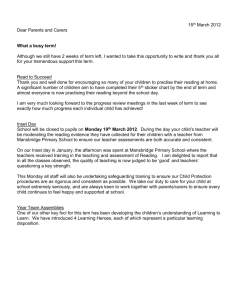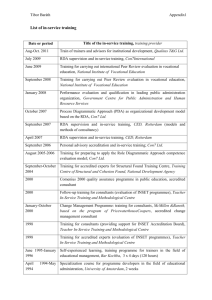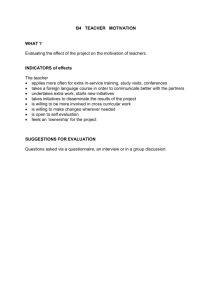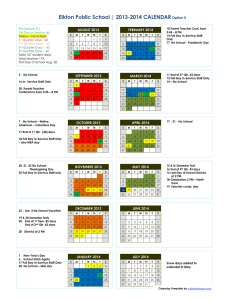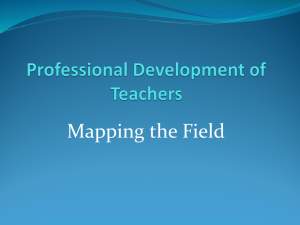Document 10464684
advertisement
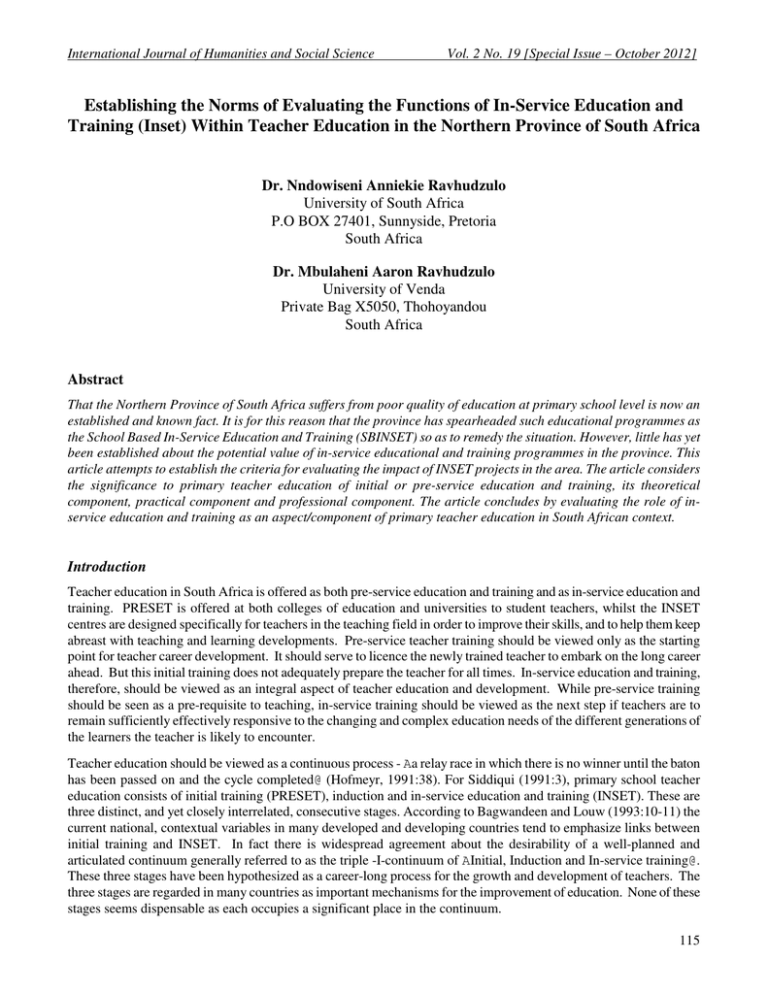
International Journal of Humanities and Social Science Vol. 2 No. 19 [Special Issue – October 2012] Establishing the Norms of Evaluating the Functions of In-Service Education and Training (Inset) Within Teacher Education in the Northern Province of South Africa Dr. Nndowiseni Anniekie Ravhudzulo University of South Africa P.O BOX 27401, Sunnyside, Pretoria South Africa Dr. Mbulaheni Aaron Ravhudzulo University of Venda Private Bag X5050, Thohoyandou South Africa Abstract That the Northern Province of South Africa suffers from poor quality of education at primary school level is now an established and known fact. It is for this reason that the province has spearheaded such educational programmes as the School Based In-Service Education and Training (SBINSET) so as to remedy the situation. However, little has yet been established about the potential value of in-service educational and training programmes in the province. This article attempts to establish the criteria for evaluating the impact of INSET projects in the area. The article considers the significance to primary teacher education of initial or pre-service education and training, its theoretical component, practical component and professional component. The article concludes by evaluating the role of inservice education and training as an aspect/component of primary teacher education in South African context. Introduction Teacher education in South Africa is offered as both pre-service education and training and as in-service education and training. PRESET is offered at both colleges of education and universities to student teachers, whilst the INSET centres are designed specifically for teachers in the teaching field in order to improve their skills, and to help them keep abreast with teaching and learning developments. Pre-service teacher training should be viewed only as the starting point for teacher career development. It should serve to licence the newly trained teacher to embark on the long career ahead. But this initial training does not adequately prepare the teacher for all times. In-service education and training, therefore, should be viewed as an integral aspect of teacher education and development. While pre-service training should be seen as a pre-requisite to teaching, in-service training should be viewed as the next step if teachers are to remain sufficiently effectively responsive to the changing and complex education needs of the different generations of the learners the teacher is likely to encounter. Teacher education should be viewed as a continuous process - Aa relay race in which there is no winner until the baton has been passed on and the cycle completed@ (Hofmeyr, 1991:38). For Siddiqui (1991:3), primary school teacher education consists of initial training (PRESET), induction and in-service education and training (INSET). These are three distinct, and yet closely interrelated, consecutive stages. According to Bagwandeen and Louw (1993:10-11) the current national, contextual variables in many developed and developing countries tend to emphasize links between initial training and INSET. In fact there is widespread agreement about the desirability of a well-planned and articulated continuum generally referred to as the triple -I-continuum of AInitial, Induction and In-service training@. These three stages have been hypothesized as a career-long process for the growth and development of teachers. The three stages are regarded in many countries as important mechanisms for the improvement of education. None of these stages seems dispensable as each occupies a significant place in the continuum. 115 The Special Issue on Business and Social Science © Centre for Promoting Ideas, USA www.ijhssnet.com Pre-Service Education and Training (PRESET) or Initial Training as Component of Teacher Education The initial training or pre-service education (PRESET) is offered just before a teacher takes up his/her first teaching assignment. By exposing the would-be teacher to psychological, sociological, philosophical and technological ideas and principles, this stage develops in him/her a basic insight into the profession and some key skills that are required in various teaching-learning tasks and situations. This stage may well be termed as preparation for the life long journey into the teaching profession (Siddiqui, 1991:3). According to Bagwandeen and Louw (1993:10) the initial training of a teacher addresses those areas of knowledge relevant to the phase for which he/she is training and also professional course work along with planned field-based experiences. Consequently pre-service teacher training refers to the training of teachers before their employment as teachers commences. During this training academic and professional work needs to be done (Chilana, 1972:12). In Van der Linde >s opinion (1987:9) the nature of pre-service education and training involves the provision of students with an academic background in education and subject specification. The programmes create opportunities for the acquisition of teaching skills and techniques through simulations, micro-teaching and periods of practice teaching in schools. It also develops the appropriate attitudes, beliefs and social orientation considered necessary for a teacher. Within pre-service training there are academic, practical career oriented, and the professional components. The academic component comprises theoretical studies in subject sciences (majors, electives, formative subjects and the discipline, education).The practical component is aimed at acquiring teaching skills. The student teacher=s theoretical knowledge is to be applied in practical training situations, so that knowledge and teaching skills would merge (Krüger and Müller, 1988:10). The professional component covers the whole training programme. Krüger and Müller (1988:10) are of the opinion that a teacher can only act professionally when he/she commands knowledge, skills and a positive attitude towards his/her task. All these should, as far as possible, be acquired during a teacher=s training. In order to train teachers properly, these components need to be integrated to form a whole. Planners of in-service training must take these components of PRESET into consideration when designing the curriculum for in-service training to guarantee continuity and to supplement pre-service training. Henderson (1978:35) observes that during the initial period, it is impossible to foresee and provide all the future demands of the teaching profession or for individual teachers during their careers. It becomes apparent that all teachers may require some form of in-service education and training. Pre-service teacher education in South Africa was provided primarily by teacher training colleges or colleges of education which fell under the administration of the former four provinces. In addition to teacher training colleges, faculties or schools of education at universities and technikons, (which fall under the national ministry of education) have also trained teachers. The number of teacher training colleges proliferated dramatically during the 1980's in an attempt to address the educational crisis of the apartheid era. But the vast majority of the newly established colleges that catered for African students were often inefficient and costineffective (Claassen, 1995:481). This observation creates the need to establish the norms to evaluate the existing components of primary school teacher education in the Northern Province of South Africa. The Theoretical Component Hollander (1989:257) asserts that the theoretical component of PRESET consists not only of the part-disciplines of education, but also of the school subjects and the formative subjects. Francia and Johnson (1989:6) confirm the importance of education when they say that to become effective teachers, student-teachers should have a strong background in education as discipline. The educational background should include the relation of school to society, the roles of teachers and student-teachers in classrooms, an understanding of the learning process, the curriculum, instruction and the teaching-learning environment necessary to help maximise learning. The theoretical knowledge of school subjects is needed to enable the prospective teacher to teach the subject. Theoretical knowledge about appropriate teaching media and available technology must also form part of the theoretical component of teacher training. This will mean that the teachers should have a theoretical knowledge of instructional material and technology, and how to select, prepare and integrate them in a specific didactic situation. This theoretical training can increase the effectiveness and efficiency of instruction in the classroom. One of the problems is that lecturers in most disciplines have little experience with technology (McNeil, 1989:58-59) and as a result cannot train student-teachers in the use of media or instrumental technology. 116 International Journal of Humanities and Social Science Vol. 2 No. 19 [Special Issue – October 2012] The Practical Component Van der Linde (1987:6) defines Apractice teaching@ or the Apracticum@ as the opportunity that a student-teacher has to participate in the actual teaching-learning situation. It is an experience in which the student-teacher gets guided teaching and takes on more and more responsibility for directing the learning of children over a set period of time. According to Stone (1984:139) the lecturer cannot expect student-teachers to do this unless he/she has gone through the same kind of experience as a student-teacher. Practicum can be done at the college or university (institute practicum) and will encompass all the practical experiences in the teacher=s educational programme at the training institution. It can also be done, at the school (school practicum) where the strategies adopted in the institute practicum, for example micro teaching, are implemented in real school situation. The practical career-oriented component is aimed at acquiring teaching skills whereas the professional component covers the entire programme.The teacher can only act professionally once he/she commands knowledge, skills, and a positive attitude towards his/her tasks (Krüger and Müller, 1988:9). The Professional Component Wirsing (1980:16) describes what is expected of a teacher as a professional as Apossess[ing] the intellectual basis from which to bring interpretive, normative, and critical perspectives to bear on all educational phenomena@ and having a Asophisticated grasp of the large and complex world of human experience which so definitely influences his/her schooling universe and the mini-world of his/her own classroom. According to the findings of the study conducted by Hollander (1989:257) the professional training of teachers has a theoretical and practical component. To master the practical aspects of teaching means that the theoretical content must be mastered as well. Professional education is a particular form of vocational education which breaches the assumed boundary between vocational and academic education and includes ethical dimensions. The purpose of professional education is to develop competencies in professional practice and to foster commitment to the ideals of the profession. In order to develop the means to achieve high standards in academic subject qualification, personal commitment, and classroom practice Tickle (1987) suggests the need for applying theoretical knowledge to classroom practice, participation in school activities by the teacher educators and in teacher education by teachers, creating interrelationships in teacher education programmes. Ticle also proposes the provision of effective induction into the teaching career the need to put in place adequate approaches to career development and in-service education that would help educators to evaluate the norms of in-service education and training. These norms that define pre-service training need to be integrated into the in-service programmes to ensure continuity and improved performance. Induction as a Component of Teacher Education Siddiqui (1991:3) maintains that the second stage of teacher education starts when the newly trained teacher is inducted into the job of teaching in an educational institution. The period of probation is supposed to be roughly the period of one=s induction into the organisation. This part of teacher education, although less formal and the least organised, helps the new teacher to gain a better understanding of classroom realities, the tricks of the trade and with the adjustment to the school environment, to develop a greater degree of self confidence. These understandings are gradually developed during the course of working with colleagues and interacting with superiors while shouldering responsibilities at the school. Bagwandeen and Louw (1993:11) see the induction of the young teacher from the relatively sheltered environment of the college of education or university, to the harsh reality of the classroom, as a pivotal concern of education departments and school administrators In-Service Education and Training (INSET) as Component of Teacher Education According to Henderson (1978:18-20) in-service training stems from teachers= own self-motivation to improve their effectiveness and to increase their capacity to develop maximum potentialities of the children they teach. These activities should be supported. Refreshment, growth, adaptation, and status of teachers are all important elements of the rationale for in-service training in almost all the countries. In developing countries, the main motives of in-service programmes are different to those in developed countries. Three important objectives of INSET in developing countries are: upgrading the competence of teachers, extending their general education, and enhancing their qualifications. In developed countries, the teaching profession has the background of a fairly extensive post-primary education (10-12 years) whereas a significant proportion of teachers in developing countries may have enjoyed fewer years of postprimary education (4-5 years). 117 The Special Issue on Business and Social Science © Centre for Promoting Ideas, USA www.ijhssnet.com Frequently, emphasis is placed on upgrading basic education and secondarily, on the improvement of professional skills (Henderson, 1978:12). One of the main aims of in-service training is to enable the teacher to monitor and shape his/her professional development (Henderson, 1978:12). Monyoee (1991:151) asserts that in a world rocked by the explosion of knowledge, the public and the teaching profession must begin to realise that the continually learning teacher is as important as the continually learning child. In-service education must be provided for all teachers throughout their careers. Although the focus is on the teacher alone, it is necessary that education officers should also be provided with in-service training. Planned programmes for in-service education are essential for adequate professional improvement of school personnel. The demand being made on schools and on teachers makes it impossible to depend upon pre-service preparation, and the initiative of the individual teacher. This underlines the need for a well planned support programme through inservice provision, in order to improve the competencies of teachers through presentation of courses, workshops, conferences, congresses, study groups, inter-school visits, lectures, and staff development programmes (Cawood and Gibbon, 1981:15). Tchombe (1990:129) argues that in-service training is vital for the continuous professional growth and development of the practising teacher. All over the world, initial education and training is inadequate, both in its programme structuring, and entry requirements. Previous research on policy of teachers and teacher education in South Africa was poor. A national enquiry into educational provision was conducted by the Human Science Research Council (HSRC) in 1981. This resulted in the HSRC Report on Education Provision in the Republic of South Africa (HSRC, 1981), commonly known as the De Lange Report. Although this was the first thorough national inquiry into education to have been held in South Africa, it neglected to make an in-depth study of teacher education (Hartshorne, 1992:45). Siddiqui (1991:4) asserts that the third phase of the teacher education continuum namely, in-service education and training is supposed to be the longest and relatively more important than the other two stages. Several research studies have confirmed the positive contribution of INSET and its significant role in improving quality of education. Once the teacher has settled down in his/her job, the activities of INSET may start taking place. These will include all activities which he/she undertakes in order to refurbish his/her professional knowledge and competence and which help him/her to manage his/her professional responsibilities. Bagwandeen and Louw (1993:11) share the same sentiments as Siddiqui (1991:4) when they state that the third part of the triple-I-continuum, in-service education, suggests the need for a sustained programme of retraining that counteracts obsolete teaching. This phase also implies the continuation of professional development which reaches beyond the support given to beginner teachers. McGregor and McGregor (1992:181-182) refer to Hofmeyr=s (1991) research that ascertained that there are few coherent policies for INSET in South Africa. Despite great faith in INSET, public and private policies for INSET are either non-existent or inadequate. Reactive ad hoc sub-policies, operating guidelines and funding preferences are the typical substitutes for strategic planning and comprehensive, long-term policies. Hofmeyr=s interviewees believed that the absence of policy is one of the main reasons why INSET provision is often ineffective. Instead of policy, Amayhem@, Acrash courses crashing all over the place@ and Aa putting out of fires@ is encountered. INSET is hampered by a lack of human and material resources, inadequate support, poor co-ordination and negative contextual factors. Van Niekerk (1997:435) also stipulates that in-service teacher education in South Africa has not been guided by any coherent policy. Education departments, non-governmental organisations (NGO=s), distance education institutions and the private sector provide INSET, often in association with teacher organisations. Moreover, most policy-making for INSET has been a top-down process, with limited consultation of interest groups. In the public sector, very few of the INSET agencies have been involved in INSET policy-making. McGregor and McGregor (1992:182) indicate that the policy environment of INSET is not beneficial for INSET and that it must be changed to one that will encourage effective INSET. Lemmer (1998:110) acknowledges Van Niekerk=s significant contribution to INSET policy by reiterating that South Africa has never had a coherent national policy on teacher development or governance. As a result of the country=s apartheid history, 17 different employing authorities for teachers and a range of different institutions and procedures to manage them, existed when the first democratic elections were held in 1994. Furthermore, the system of teacher education was fragmented and racially and regionally determined. As a result of these problems, the need to reconstruct policies for teacher development, utilisation and supply became apparent. 118 International Journal of Humanities and Social Science Vol. 2 No. 19 [Special Issue – October 2012] The process of policy development has however been hampered by a general lack of comprehensive, up-to-date and comparable data on teacher demand and supply and the provision of teacher education in the country. Empirical evidence concerning the numbers and distribution of teachers across racial groups, regions and academic disciplines is sorely lacking. Lemmer (1998:114) also mentions that the system of teacher education is under review. In this regard the draft White Paper on Higher Education (Republic of South Africa, 1997) and the discussion document on National Policy on teacher supply, utilisation and development (Department of Education, 1996) recommended that teacher education should be seen as a unified field which belongs in a system of higher education. This recommendation has already led to the closing of several teacher training colleges and the planned incorporation of colleges into the system of university governance. According to the same discussion document mentioned above, teacher education should be based on the five basic principles underlying education according to the 1996 Constitution. These are global and national relevance; learner-centredness; professionalism; co-operation and collegiality; and innovation. The curriculum for both PRESET and INSET should be congruent with Norms and Standards for Educators (1998) and National Qualification Framework (NQF), and should include training for Early Childhood Education, Adult Basic Education and Training, Vocational Education and Education for Learners with Special Needs. National policies should be comprehensive and flexible in order to cater for the different needs and developmental stages of a varied teaching force. However, experience has shown that a critical mass of teachers must be targeted in order for INSET to produce any institutional and system effects. Hofmeyr (1991:54) is of the opinion that INSET policies must focus on schools rather than individual teachers as the units of change. Consequently it is the school that is the smallest viable unit of change. The individual school or clusters of schools become the forum in which the different needs of teachers can be accommodated. At the national level, certain enabling conditions would need to be addressed by policy initiatives so that the chances of effective INSET are increased. Here government can play a powerful role by providing an appropriate legislative framework and making available the minimum necessary resources and expertise that allow for successful INSET. The provision of adequate material and human resources appears to be urgent in rural areas of developed and developing countries. What seems to be needed is a national approach to INSET which includes local option policies so that schools can accommodate particular teacher needs within a framework of system policy and support. Bagwandeen and Louw (1993:18), further argue that INSET programmes in most countries are meant to provide effective and cost - effective education that ensures the continuing education of teachers whether unqualified, underqualified or qualified. Conclusion This article has established that the primary school education system of the Northern Province of South Africa is poor. Because of this situation, INSET programmes were put in place in order to change the complexion of educational curriculum in the province. The article has identified three main interventionist strategies that could help make a difference when applied to the primary school education system in the Northern Provinces. These components of teacher education are the initial training, induction and most importantly, in-service education and training. Initial training or pre-service education and training prepares primary school teachers for the life long journey into the teaching profession. This stage offers academic background to the teachers. It also creates opportunities for the acquisition of teaching skills and techniques through simulations, micro teaching and periods of practice teaching in schools. The induction phase or component of teacher education helps the new teacher to gain a better understanding of classroom realities. The final and all-important stage of in-service education and training is the defining moment of retraining of primary school teachers under the aegis of the school based in-service education and training programme. The INSET programme enables the teacher to monitor and shape his/her professional development. As this article has indicated, a national approach to INSET which includes local option policies that accommodate particular teachers needs a framework of system and support. 119 The Special Issue on Business and Social Science © Centre for Promoting Ideas, USA www.ijhssnet.com References BAGWANDEEN, D. R. & LOUW, W.J. 1993. The theory and practice of in-service education and training for teachers in South Africa. Pretoria: Van Schaik. CAWOOD, J. & GIBBON, J. 1981. Educational leadership: Self development. Cape Town: Nasou Limited. CHILANA, M. R. 1972. In-service education of elementary teachers. New Delhi: Indian Association of Teacher Educators. CLAASSEN, J. C. 1995. The education system of South Africa. In: DEKKER, E.I. & VAN SCHALKWYK, O.J. (eds). Modern education system. Second edition. Durban: Butterworths. DEPARTMENT OF EDUCATION. 1995. Towards the restructuring of INSET programmes as an educational system in the Northern Province: A discussion document, June 1995. Pietersburg: Government Printers. DEPARTMENT OF EDUCATION. 1996. Guidelines on INSET and ongoing professional development, 17 September 1996. Pretoria: Government Printers. DEPARTMENT OF EDUCATION. 1997. Policy on teacher education. Pretoria: Government Printers DEPARTMENT OF EDUCATION. 1998. The teacher development centre. Pretoria: Government Printers. FRANCIA, K. & JOHNSON, M.S. 1989. Survey of general trends in teacher education in the United States of America. New York: State University of New York Press. HARTSHORNE, K.B. 1992. Crisis and challenge. Black Education 1910-1990. Cape Town: Oxford University Press. HENDERSON, E.S. 1978. The evaluation of in-service teacher training. London. Croom Helm Ltd. HOFMEYER, J.M. 1991. Policy change in South African Education: The roles of the public and private sectors in inservice teacher education. Unpublished Doctor of Philosophy thesis. Johannesburg: University of Witwatersrand. HOFMEYER, J. & HALL, G. 1995. The national teacher education audit: Synthesis Report. Braamfontein: Research Institute for Education Planning (OFS) South African Institute for Distance Education (SAIDE). HOFMEYER, J., SALMON, C., SHAW, M., MBULAWA, E., DE WEE, K., COOK, C. & LETUKA, J. 1995. Report of the National Conference on teacher development. 1-3 August 1995. Midrand: Gauteng Province, South Africa. HOLLANDER, W.J. 1989. Lesstruktuurverwante onderwyshandelinge in opleidingsperspektief. D.Ed.- proefskrif. Johannesburg: Randse Afrikaanse Universiteit HUMAN SCIENCE RESEARCH COUNCIL. 1981. Report of the main committee: Provision of education in the Republic of South Africa (RSA). Pretoria: HSRC VOL: 66. HUMAN SCIENCE RESEARCH COUNCIL (eds). 1996. Towards an operational framework for teacher development and Support. Proceedings of a National Conference held at Riverside Sun Vanderbijlpark 13-15 October 1995. Braamfontein: Aurora Associates International. KRÜGER, R.A. & MÜLLER, E.C.C. 1988. Teacher training: Lesson structure and teaching success. Johannesburg: Randse Afrikaanse Universiteit. LEMMER, E.M. 1998. Issues in teacher supply, utilisation and development in South Africa. In: PRETORIUS, F. & LEMMER, E. South African education and training: Transition in a democratic era. Randburg: Hodder & Stoughton. McGREGOR, R. & McGREGOR, A. 1992. Education alternatives. Kenwyn: Juta & Co, Ltd. McNEIL, D.R. 1989. Technology in college: Where is its impact? Education Digest. 55: 58-59. MCNEIL, J.D. &. WILES, J. 1990. The essentials of teaching: Decisions, plans, methods. New York: Macmillian. MONYOEE, A. L. 1991. Educational review: Lesotho=s unfinished agenda. South African Journal of Higher Education. 5 (2): 149-151. SIDDIQUI, M. A. 1991. In-service teacher education. New Delhi: Ashish Publishing House. STONES, E. 1984. Supervision in teacher education. London: Methuen and Co. Ltd. TCHOMBE, T.M. 1990. In-service and continuing professional development in Cameroon. In: HO, W.K. Improving the quality of the teaching profession. Singapore: ICET TICKLE, L. 1987. Learning teaching, teaching learning. Philadelphia: Falmer Press. TICKLE, L. 1989. On probation, preparation for professionali. Cambridge Journal of Education, 19 (3): 38-52. VAN DER LINDE, P. 1987. The practicum as a school-based component of teacher preparation. Education Bulletin, 30 (1): 5-17. VAN NIEKERK, L.J. 1997. Teachers and teaching. In: LEMMER, E.M.& BADENHOST, D.C. (eds.) 1997. Introduction to education for South African teachers: An orientation to teaching practice. Cape Town: Juta & Co, Ltd. WIRSING, M. 1980. The artist is he who dances in chains. Paper presented at the Foundations of Education Symposium, Education for the 1980s, Cheney, Washington, July, 1980. 120

